The summer heat and winter frost can be terrible to live with when you reach the heart of both seasons.
We’ll guide you through the best ceiling fans for the ultimate performance in air circulation and temperature control. What’s more, we’ll help you choose the top option for your home, work, or outdoor life.
At a Glance: Our Top Picks for Ceiling Fans
- OUR TOP PICK: HUNTER 53091 Builder Deluxe
- RUNNER-UP: Honeywell Palm Island
- BEST BUDGET OPTION: Honeywell 50609-01 Xerxes
Comparison of the Best Ceiling Fans
| IMAGE | PRODUCT | |
|---|---|---|
Our Top Pick  |
| View Latest Price → |
 |
| View Latest Price → |
Best Budget Option  |
| View Latest Price → |
 |
| View Latest Price → |
 |
| View Latest Price → |
 |
| View Latest Price → |
 |
| View Latest Price → |
How to Choose a Ceiling Fan
We know that selecting the best ceiling fans can be daunting. We’ve put together a list of a few factors you should consider before buying one.
Airflow and Efficiency
You’ll want the best performance to control the air and temperature in any situation. Always look at how much CFM the ceiling fan can generate and determine if it’s sufficient for your purposes. Furthermore, check the wattage to calculate the energy efficiency rate in CFM/W.
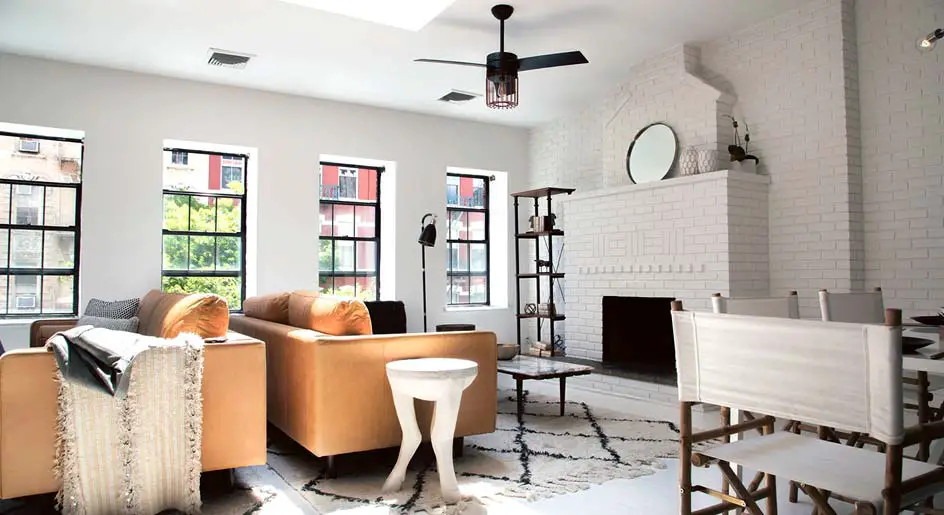
Photo credit: lightology.com
Blades
Blades have some of the most significant roles to play in airflow generation. You’ll see variations for blade numbers, span, finish, pitch, and style. Some are merely for appearance, while others relate to performance.
Lighting
In most cases, your new ceiling fan will replace the room’s central light fitting. If this happens to you, you’re going to need a unit with enough lumens to see what you’re doing without blinding you. You can estimate how much brightness you need by measuring the space, but buying a unit with a dimmer switch also helps.
Purpose
There are different ceiling types for various purposes. For instance, low profile hugger units are perfect for small spaces with low ceilings. You’ll also find fans specifically designed for outdoors, while portable ones are easy to transport with you on your travels.
Review of the Best Ceiling Fans
While there may be hundreds of products on the market, we’ve hand-picked our selection of the best ceiling fans.
Best Overall:
HUNTER 53091 Builder Deluxe

PROS
CONS
What Recent Buyers Report
Most customers were impressed that the Hunter ceiling fan came with a balancing kit for the blades. They loved the colors and design, with a few remarking on the light bowl’s toffee finish. One buyer was pleased with the warranty after an issue with the motor speed, resulting from operating for several years.
Why it Stands Out to Us
We’re quite fond of five-blade designs that make a room more appealing. The New Bronze, Builder Deluxe Hunter standard delivers excellent airflow performance for medium-sized rooms. If you’re worried about ceiling height, you can choose between 2” and 3” downrods.
Hunter’s Whisper Wind motor technology comes to the fore for silent fan operation. You can reverse the direction of the blades for optimal temperatures in winter and summer. While there may not be a remote included, feel free to change the lighting and speeds with pull-chain control.
Bottom Line
This Hunter’s product stands out as the best ceiling fan thanks to its durable design and excellent performance. If you’re struggling with a unit at home, you may want to consider replacing it with this one, as so many buyers did. You’ll find its versatile features suitable for any room in your home.
Runner-up:
Honeywell Palm Island

PROS
CONS
What Recent Buyers Report
Buyers mentioned satisfaction that they could install this ceiling fan inside and outside. They enjoyed the palm-leaf design and silent motor, while a few said it was easy to install. There are mixed opinions about whether there’s sufficient airflow, with some reviewers realizing that they installed the blades the wrong way round.
Why it Stands Out to Us
This Honeywell unit is the best ceiling fan for similar thematic settings. There are four speeds for the palm-leaf blades, giving you the feeling of staying in a tropical paradise. The motor is silent with the option to switch directions for cooling or heating the air.
The 52” fan span is suitable for medium to large rooms, delivering 3,516 CFM at the fastest speed. The blades are made of ABS plastic, so you can expect durability and a long lifespan if well-maintained. While we prefer remotes for ceiling fans, you can purchase a universal Honeywell one instead of the pull-chain.
Bottom Line
The Honeywell Palm Island ceiling fan is delightful, and you’ll love placing it in any of your rooms where you’re looking for that tropical setting. We find it looks fantastic above bars or in entertainment areas, while you can also install it in outdoor areas.
Best for the Money:
Honeywell 50609-01 Xerxes

PROS
CONS
What Recent Buyers Report
While many customers have mixed reviews regarding the installation, most of them said it’s challenging to undertake on high ceilings. They enjoyed the airflow and powerful lighting, stating how well it performed in large areas. Some buyers purchased extra rods for a further extension from the ceiling.
Why it Stands Out to Us
The first aspect that appeals to us is the eight-blade design. The dark colors look stunning in an environment laden with timber furnishings and trims. The unit has outstanding speeds and light settings, which you can control with a remote or your voice.
You have three mounting options, namely, angled, flush, and downrod. With a fan diameter of 62”, you’ll receive sufficient airflow for massive spaces. There’s also powerful lighting, giving you up to 1,400 lumens that you can dim to the appropriate level. This feature makes it compatible with any room size.
Bottom Line
If you’re looking for quality for your money, this Honeywell unit is the best ceiling fan that fits the bill, so to speak. It has several features for you to enjoy at a fantastic price. You can choose your mounting method, light settings, and speed levels while also deciding how to control the fan.
Best Outdoor Ceiling Fan:
Honeywell Belmar 52-Inch Ceiling Fan

PROS
CONS
What Recent Buyers Report
Customers were impressed with how much airflow this ceiling fan produced compared to products at the same prices. They mention that the motor is heavy-duty and capable of cooling any area outside. Furthermore, they enjoyed how silent it is while running at full speed.
Why it Stands Out to Us
Honeywell delivers a sleek unit with loads of muscle power with this outdoor ceiling fan. You can install it close to the surface or drop it with a downrod, depending on the ceiling type you have. If you have an angled structure overhead, the angled mounting kit is perfect.
The entire unit has an oil-rubbed bronze appearance, which will suit dark and light patios. While it has pull-chain control, you’ll have to purchase the remote control separately if you have a high ceiling. Whether you’re using it for winter or summer, you’ll enjoy the performance of the silent motor.
Bottom Line
The Honeywell Belmar 52” ceiling fan looks fantastic in any outdoor setting, whether you have dark or light themes. While we would have preferred the remote sold with the product, it still produces high airflow. It also helps that all the components are protected from the weather.
Best Ceiling Fan With Lights:
Brightwatts 52-CRB
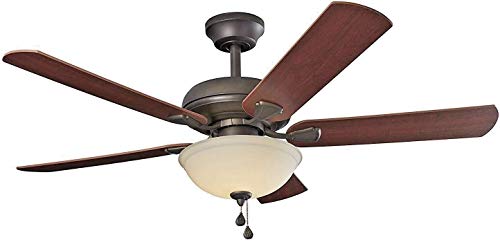
PROS
CONS
What Recent Buyers Report
Many customers agreed that this ceiling fan’s light is incredibly bright and suitable for large spaces. There was mention of it being challenging to install, but only because the instructions weren’t of good quality. Overall, they were satisfied with the airflow performance and nutmeg finish.
Why it Stands Out to Us
The five blades look fantastic in nutmeg or espresso, albeit we do prefer the latter. The 3,900 CFM airflow might be lower than some of the other best ceiling fans we’ve reviewed, but it has an outstanding efficiency of 89 CFM/W. The three reversible speeds ensure optimal temperatures through the summer and winter seasons.
Of course, its top feature is the elegant glass bowl light fitting, hitting our spot for the best ceiling fan with lights. The LED bulbs deliver excellent lighting for any room size, although it’s probably best suited for large areas. If you’re aiming to install it in a small space, ensure that you include a dimmer switch.
Bottom Line
Not only does this unit look amazing, but the brightness will light up your life. Besides the glass bowl shape, you’ll enjoy the housing and blade finishes. The airflow efficiency ensures that you won’t use up too much electricity while running the blades at full speed.
Best Ceiling Fan for Bedroom:
Harbor Breeze Mazon

PROS
CONS
What Recent Buyers Report
Many customers loved the brushed nickel housing and blades. They were pleased to receive a remote and wall bracket and mentioned that the airflow was sufficient for medium-sized bedrooms. The only concern was with the LED bulbs that were irreplaceable.
Why it Stands Out to Us
When it comes to ceiling fans for bedrooms, we enjoy flush mounting and an elegant design. The light is incredibly bright for small rooms, but the airflow is perfect. With three reversible speeds, the three blades do their best to moderate the room temperature.
Comfort is everything in a bedroom. We’re pleased that there’s remote control instead of pull-chain controls. While there aren’t any other options for installing on high or angled ceilings, you’ll still enjoy it in your room if you have a flat surface. It also helps that it’s easy to install.
Bottom Line
This Harbor Breeze unit is an excellent addition for any bedroom, with its low profile and airflow performance. The brushed nickel makes it stand out, especially when the bright LED light is on in the middle of the night. You’ll be impressed with how much air it circulates with three blades.
Best Ceiling Fan for Large Rooms:
Harbor Breeze Twin Breeze II
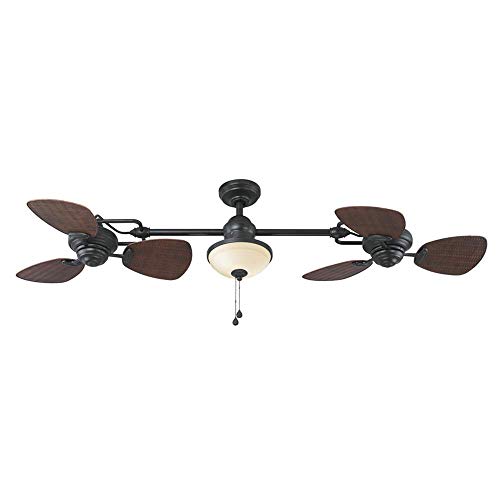
PROS
CONS
What Recent Buyers Report
Buyers were surprised to find that they didn’t need to install the light fitting, as it included a cover cap if preferred. They discovered that both fans could tilt, which added a different dimension to the airflow concentration. Customers also mentioned satisfaction with the light’s brightness.
Why it Stands Out to Us
This exquisite ceiling fan stands out for large rooms due to its unique design. There are two fans on either side of a central light platform, providing airflow on two different sides. If you have over enough space to play with in your room, this unit is perfect for you.
The bronze housing suits rooms with dark and light themes, while the wicker blades would go well in a lodge or guest house. The package includes a 4” downrod, but you can order an extended rod separately. While it has pull chains for controlling the speed and light, you can purchase a universal remote.
Bottom Line
You might have massive rooms in your house or lodge that requires several fans in one space. Well, this product has two ceiling fans in one to solve that issue, producing excellent airflow and lighting.
Lowest Profile Ceiling Fan:
Hunter Indoor Low Profile IV

PROS
CONS
What Recent Buyers Report
While customers were satisfied with this low profile ceiling fan’s size, a few expressed surprise at how bulky the housing is. Overall, it provided sufficient airflow for rooms up to 200 sq ft. Buyers found it perfect for areas that didn’t need the unit to have lighting.
Why it Stands Out to Us
Out of the two blade finishes available, we liked the weathered oak the most. The flush mounting works perfectly for short ceiling heights and will help you stay within those building regulations. The New Bronze housing color will match room interiors that have oak trimmings or themes.
Despite its small size, it still manages to push 2,902 CFM airflow to ensure that your room stays cool or warm. The pull-chain control suits this unit, as you’ll quickly reach it with low ceilings. Of course, you do have the option to purchase the remote if you prefer.
Bottom Line
Hunter’s low profile ceiling fan will work wonders in most rooms up to 200 sq ft, depending on the space layout. If you have a different light source, you don’t need to worry about installing a light kit. You’ll love the color finishes that’ll go well with light or dark themes.
Quietest Ceiling Fan:
Hunter Sentinel Ceiling Fan

PROS
CONS
What Recent Buyers Report
Buyers became creative when connecting this unit to a wall switch instead of using the remote control. They loved the silent motor while marveling at the unique brushed-slate finish. The lighting was adequate for medium-sized rooms, and many said the airflow was sufficient.
Why it Stands Out to Us
We’ve seen many finishes in our time reviewing the best ceiling fans for different environments. Oil-rubbed bronze, brushed nickel, and white are the tones we see the most. Brushed slate isn’t a color we’re accustomed to, which is why we love this unit.
Of course, it made our list due to its silent performance. Hunter’s Whisper Wind technology is known for quiet running, but it seems that this ceiling fan outperforms the others. It also helps that there are only three blades to cut through the air.
Bottom Line
This ceiling fan might have a low profile, but it has a wide span of 52” that delivers powerful, silent air circulation. There aren’t many features to boast about, albeit the lighting and remote are items worth mentioning. The brushed-slate finish gives it that final touch that places it on our list of the best ceiling fans.
Best Ceiling Fan for Kitchens:
Minka-Aire F844-DK

PROS
CONS
What Recent Buyers Report
Clients enjoyed the appearance and dimmable lights, stating that it had adequate airflow performance. A few remarked that there was minor hum at fast speeds and mentioned that it could be due to the blades. While some installed it in kitchens, others also used it in bedrooms.
Why it Stands Out to Us
The reason we selected this ceiling fan for kitchens is due to the solid wood blades. It can handle continuous steam from hours of cooking, being able to withstand various external factors. The unit also delivers a whopping airflow of 5,024 CFM, which is over enough to drive the smoke away.
The motor is also reversible, so you can keep your kitchen warm during the winter months. The bright light has a dimming function for when you want lower or higher intensity. You can use the elegant remote control to set the right mood.
Bottom Line
If you’re looking for a kitchen ceiling fan that will withstand the fury of your extensive cooking, this unit will last you many years. You can also use it as the central lighting source so that you can see what you’re chopping on the counter.
When Is It Time to Replace My Ceiling Fan?
The best ceiling fans have a lifespan of about eight to ten years, and that’s only if you’ve looked after them and performed proper maintenance. The purchasing price isn’t an indication of how long the unit will last, which is a common misconception. Instead, it depends on the quality of each component in the system.
You can usually repair most ceiling fan issues. However, here are some signs that your unit may need replacement:
- Constant buzzing after several years of silent performance, indicating your capacitors, motor windings, or laminates reaching the end of their lifespans;
- Uncontrollable wobbling not related to unbalanced blades or loose fittings;
- Continuous squeaking despite adequate lubrication;
- Speed reduction with no indication of loose wires or connections;
- Regular maintenance issues that return despite professional assistance.
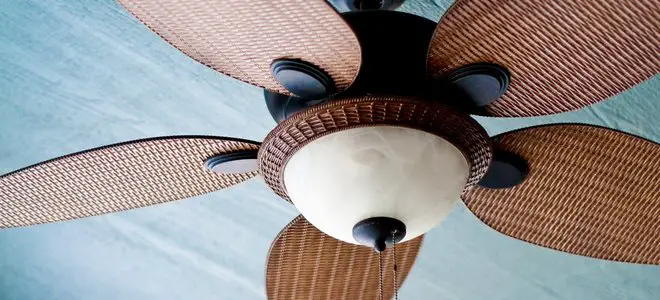
Photo credit: cimg1.ibsrv.net
Safety Considerations in Purchasing Ceiling Fans
When you’re ready to buy a ceiling fan, you need to bear some vital safety factors in mind. Ensure that you read this section before clicking on that online order button.
Electrical Requirements
The motor and lighting have several wires and circuits to ensure that the ceiling fan runs smoothly. In some cases, you can merely connect them up to the wiring already available in your ceiling. In other situations, you may need to pull through new wires or install a conduit.
You should also pay attention to the wattage and light bulb types. Finally, check whether the ceiling fan requires AC or DC voltage and if it matches the intended location.
Adequate Instructions
One element you should assess is whether there are sufficient instructions for installing the ceiling fan, as poor assembly can lead to disastrous consequences. The number one way of discovering this aspect is reading through product reviews. If you purchase a unit with bad instructions, you can contact the seller or manufacturer for better details.
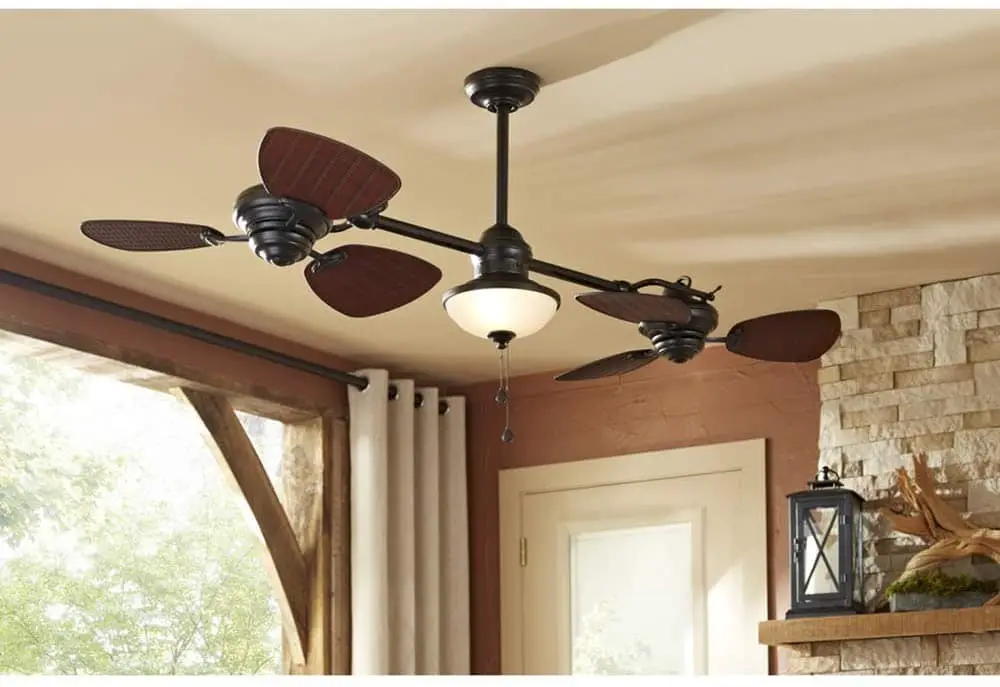
Harbor Breeze Twin Breeze Ii
Mounting Options
If you have a low ceiling, you’ll need to look at which mounting methods are available with the ceiling fan to avoid the blades hitting anyone’s head. As per building regulations, the fan must be at least seven feet from the floor, with ample space around it on either side. You’ll want to aim for a low profile hugger ceiling fan.
Support Requirements
Finally, you’ll need to look at what the ceiling fan weighs. Do you currently have support for that weight at the desired location, or do you need to purchase a mounting bar? You don’t want to install the unit and have the ceiling board crashing down by the end of the week.
Types of Ceiling Fans
It’s essential that you pay attention to the ceiling fan type before you buy one. They have different features and functions and aren’t compatible with all environments.
Standard
These ceiling fans are available in various sizes and includes a downrod so that you can drop it to different height levels. You’ll usually use these when you have sufficient space and ceiling height in the location. It may contain a wealth of extra features, such as lighting, remote and voice control, and variable speeds.
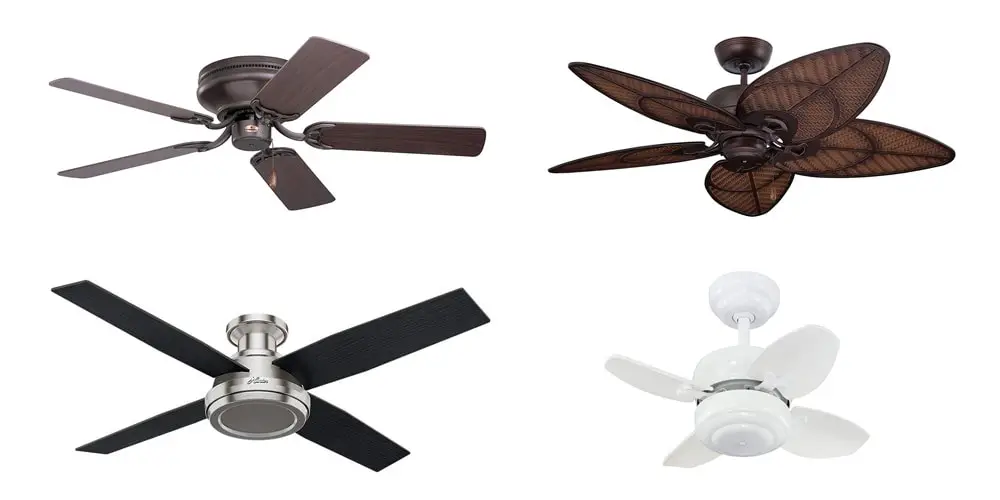
Photo credit: floodlightsblog.com
Low Profile
Hugger and flush-mount ceiling fans are perfect for when you have limited height. They install right against the ceiling with unique mounting systems. You’ll generally find fewer features available, which also makes it more affordable than standard units.
Outdoor
There are ceiling fans designed explicitly for outdoor life. They have wet and damp ratings that reflect how much water vapor, rain, snow, or strong winds they can withstand.
Portable
These units are excellent for if you regularly travel to camping spots or vacation locations and you want to take your ceiling fan with you. They are quick to disassemble and assemble, while their lightweight designs make them easy to carry and transport.

Photo credit: thehighlyrated.co
Ceiling Fan Comparisons
Besides the ceiling fan types, there are other comparisons you can also make. Here’s a quick look at some of them.
Ceiling Fan vs AC
Both ceiling fans and air conditioners provide temperature control, but the latter has better performance in doing so. It dehumidifies the air instead of merely circulating it. However, it comes at high upfront, electrical, and maintenance costs.
While fans are more cost-effective, there are generally more safety hazards. For instance, the spinning blades pose a danger, and the unit can fall from the ceiling if not correctly installed. On the plus side, they don’t emit harmful pollutants or gasses as some aircons do.
Ceiling Fan Settings Summer vs Winter
Most ceiling fans have reversible speeds. The primary reason is to combat warm air in summer and cold air in winter. If you don’t have your unit’s settings right, it can cause high utility costs.
Which Way Should Ceiling Fans Turn in Summer?
Ceiling fans rotate counterclockwise in summer to push the air down and cool the room.
Which Way Should a Ceiling Fan Turn in the Winter?
In winter, the blades should turn clockwise to warm the air.

Photo credit: martecaustralia.com.au
3 Blade vs 5 Blade Ceiling Fan
If you bought ceiling fans with three and five blades with the same pitch, brand, material, shape, finish, and motor, the five-blade unit would produce more airflow and perform better. However, three-blade versions have different designs to deliver better results. You may just find three blades better than five in some cases.
The theory is that five blades create better airflow due to more spaces between them. You need to keep in mind that it also adds weight and drag on the motor, which slows down the potential maximum speed. You need a more powerful engine to spin five blades than three, so the latter becomes more affordable.
Are 3 or 4 Blade Ceiling Fans Better?
The same rules apply here. While the difference is less noticeable, you’ll generally find that the three blades are more efficient for electrical costs and airflow generation. However, many homeowners enjoy both versions, and it comes down to personal preference and taste.
Another aspect you should consider is noise. The three-blade version has fewer parts chopping through the air, so you can expect complete silence at all speeds. Four blades tend to hum as they spin, while five may sound like helicopter blades at full speed, depending on the design.

Photo credit: bunnings.co.nz
How to Install a Ceiling Fan
If you’re purchased one of our recommended best ceiling fans, it’s always a good idea to hire professional help for the installation. However, you may know enough about the electrical wiring to mount the unit. Please take all necessary precautions.
Here’s a quick overview of how to install a ceiling fan:
- Turn off all power leading to the installation area by the breaker to prevent any mishaps;
- Measure where you’d like to mount the ceiling fan, generally in the center of the room;
- If you’re replacing an existing fitting, ensure that you remove it safely while keeping the ceiling wires in place;
- Install the mounting bracket;
- Assemble the motor and housing before attaching the wires to the ceiling;
- Connect the housing or downrod to the mounting bracket and secure it with the canopy;
- Attach the fan blades to the irons before connecting them to the motor;
- If you have a light fitting with your ceiling fan, be sure to attach that next;
- Once all the components are securely in place, return the power, and test the fan.
For a complete guide, please refer to this video:
How to Clean Ceiling Fans
You’ll reach the stage where you need to clean the fan blades from any collected dust. In this section, we’re going to take you through a few steps to follow:
- Switch off the power to prevent any accidents;
- Place a bandana or mask on your face and protective eye-wear to prevent any particles from falling on them;
- Put a sheet on the floor to catch any dust as it falls;
- For high ceiling fans, you can use an extended rod with a brush at the end to clean each blade;
- For low profile fans, stand on a step-ladder and clean each blade with a cloth. You can also use a pillowcase to clean and catch dirt at the same time;
- Return the power and enjoy your newly cleaned fan.
Here’s another video you can refer to:
Conclusion
Choosing the best ceiling fan among thousands available online is incredibly challenging. There are so many factors to look out for, and installing them is another issue altogether. We hope that our guide has helped you towards a better understanding of these fantastic products.
People Also Ask
We might have left you with a few questions unanswered. Let’s look at a few FAQs for the best ceiling fans.
Can Ceiling Fans Be Too Big For a Room?
Not all rooms have enough space for a large ceiling fan. Building regulations dictate that the floor-to-fan height must be at least seven feet, with sufficient space around the blades. You need to ensure that you purchase a unit that complies with these stipulations.

HUNTER 53091 Builder Deluxe
Which Type of Fan Gives More Air?
Standard ceiling fans with downloads and between three and five blades are excellent for delivering high airflow. Low profile units struggle to amass the same circulation with the small space between the blades and ceiling. You should aim for products that have high CFM.
What Is the Best RPM For Ceiling Fans?
While most buyers study the CFM for airflow, you can also check the rotations per minute (RPM). Standard ceiling fans run at about 300 - 350 RPM, while those with high speeds reach 380 - 390 RPM.
How Far From the Ceiling Should a Ceiling Fan Be?
As per building regulations, the ceiling fan must be at least seven feet from the floor. If you have a ceiling higher than eight feet, you can play with different distances from the ceiling with a downrod.
How to Balance a Ceiling Fan
If you find that your fan is wobbling, there’s a good chance your blades are out of balance. You can measure the distance of each one from the ceiling. If there’s a discrepancy, find the closest one to the surface and tape a weight or coin on it to balance it out.
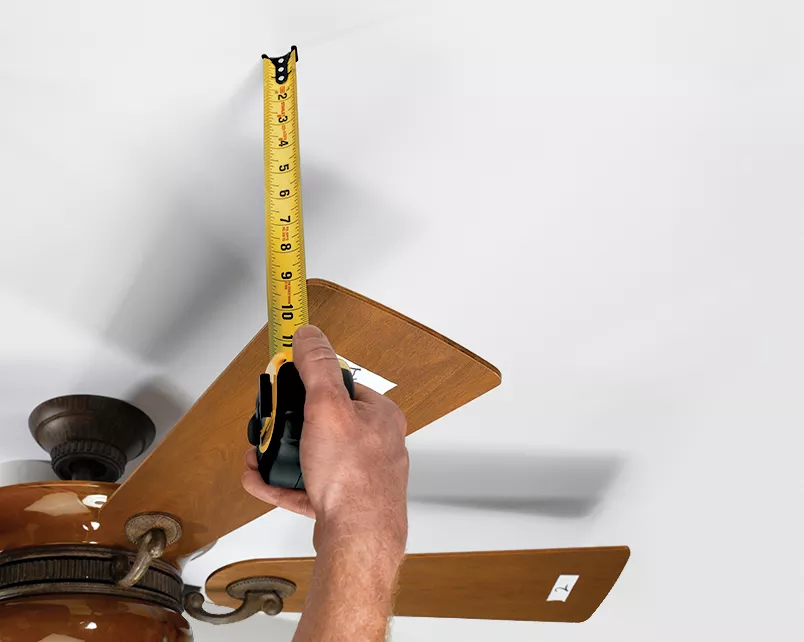
Photo credit: cdn.vox-cdn.com
How to Measure Ceiling Fan
Take a measuring tape and start at the end of one blade. If there’s an uneven number of blades, measure to the center and multiply the radius by two. With even blade numbers, you can stretch it across the entire diameter.
Which Way is Clockwise on a Ceiling Fan?
If you’re looking at the ceiling fan from the floor, clockwise refers to the blades turning to the right.
How Much Electricity Does Ceiling Fan Use?
It depends on the model. Every ceiling fan consumes a different amount of watts, generally between 45 and 100. Units that push the most airflow at the lowest wattage are the most efficient.
Ceiling Fan Guides
Here are all of our ceiling fan guides for your convenience:
